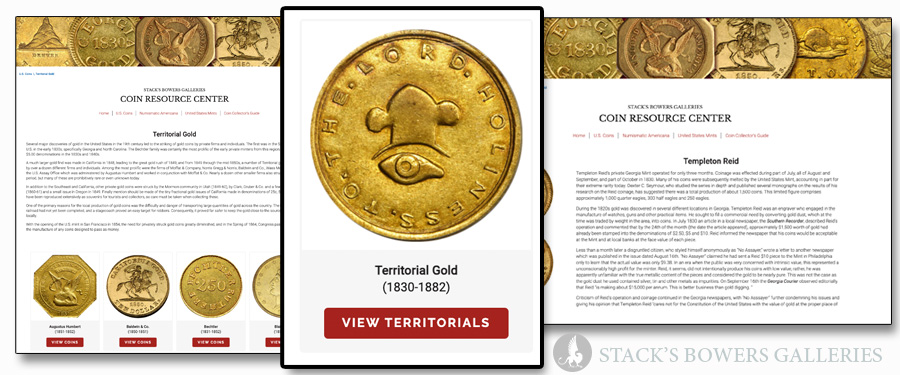
Stack’s Bowers Galleries’ Coin Resource Center includes a wide range of numismatic material not produced/issued by the federal government. Last week, this blog covered the Coin Collector’s Guide on Territorial gold; this week we’ll be looking at the entries for Territorial gold pieces.
Thirty-five different firms are included, with information on their histories and individual pages detailing the patterns, coins, and/or bars they issued. A broader description of territorial gold as class of numismatic collectible accompanies the firm listings, like the series descriptions that accompany the pages detailing individual dates for federally-issued coins.
The territorial gold coinage firms listed in the CRC issued coins between 1830 and 1882 across several American locales. The earliest were assayers and private coiners in the Southern mountains, including the Bechtler family in North Carolina and Templeton Reid in Georgia, active from 1830 onwards as the first major United States gold rush got underway. The impetus for much of the local coinage was the difficulty and danger in transporting large quantities of gold bullion and a scarcity of circulating coins around the goldfields, which were often on the frontier of the expanding nation.
Subsequent rushes farther west spurred the issuance of more Territorial Gold, with well-known issues from California and, later, Oregon, Colorado, and Utah. The San Francisco Mint’s opening in 1854 reduced demand for privately-minted coins in the West and provided a more convenient outlet for gold and silver mined in the region. A decade later, Congress passed a law essentially banning the production of privately-struck coins intended for circulation, putting paid, for the most part, to the issuance of territorial gold. Private coiners in California continued producing small gold charms denominated $1.00 and under into the 1880s (these are also covered in the CRC). Some territorial gold issues are extremely rare and not fully understood. The paucity of documentation and few surviving examples of their coinage make studying these makers very challenging. The CRC communicates what is known about different issuers, acknowledging gaps in numismatic knowledge where they exist. As with other numismatic subfields and individual entries in the CRC, we invite collectors, experts, dealers, and other knowledgeable readers to offer corrections where appropriate.





